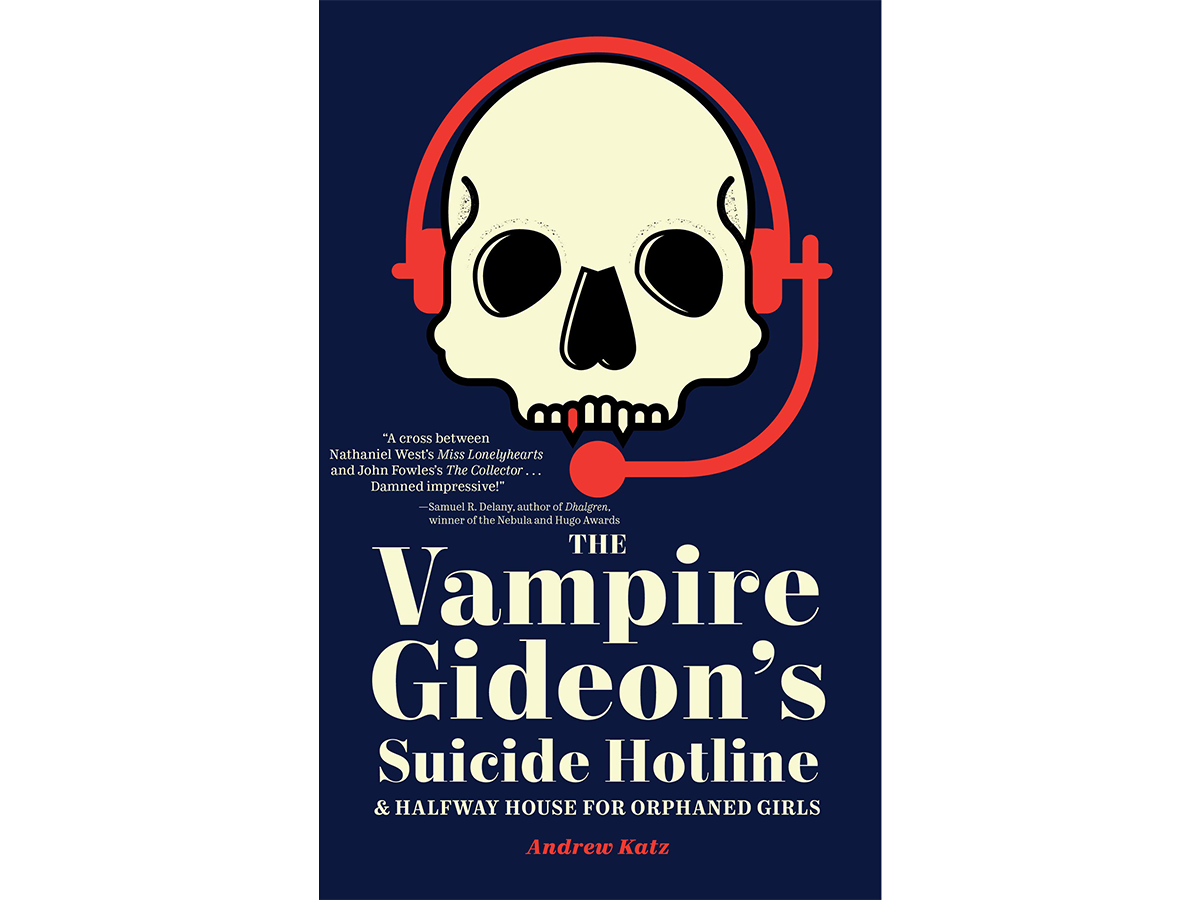Andrew Katz’s The Vampire Gideon’s Suicide Hotline & Halfway House For Orphaned Girls is a look into whether or not you are responsible for the happiness of others, especially when you’re dead. If you’re one of the (un)lucky few who know what death is like, why not start up a suicide hotline to save your community from that same fate?
When Gideon was turned into the vampire he is today, it was traumatizing to say the least. He doesn’t like to talk about it, having lost those he cared about as a result of the ordeal. Living with the consequences of those events, both mental and physical, have taken a toll on him. Gideon knows how awful it feels to be dead, so why not help those who desperately need it? “Desperate” is the key word here; Gideon isn’t exactly certified to be doing this sort of thing, so he shows up deep into Google’s search options. If someone needs his help that badly (meaning, they’ll scroll through nine pages of suicide hotline results until they stumble across him), then that’s time well spent. If he could spend some of his infinite hours encouraging the living to keep going, then his unqualified advice might be worth something to someone. Plus, he’s immortal, so it’s not like he’s short on time anyway.
Gideon meets quite a few interesting characters throughout his time running the suicide hotline. The reader is introduced to Jacob, a repeat-caller who Gideon gives “homework” to in an attempt to better him. It’s self-help tasks, like talking to a stranger to make a new friend, but those tasks make all the difference to Jacob. We also get to hear from Rich, another repeat caller who tries to help Gideon (in his own way) by calling him out on truths and lies. Smaller, though still interesting, callers to the hotline include Curtis, Gordon, and Vanessa.
I personally wish we had heard more from Vanessa. A depressed mother who is terrified of herself and hurting her children is a harrowing idea, but I was engaged by her story every step of the way. Every time Gideon received a call, I hoped it was her. Is she okay? Are her kids safe, or did she finally succumb to her demons?
On the other hand though, the infrequency of Vanessa’s calls makes her storyline that much more interesting. The fear and desperation in every call with her, paired with the unknown fate of her family for pages and pages, creates a tension that works perfectly. A mother that’s terrified of killing herself and her two children should make you uncomfortable.
My desire to know more about Vanessa is rooted in “what ifs?” What if she called more? What if she got the help she needed? What if she actually hurt her children? What if she called 911 instead of Gideon the first time around? Could she have been saved? The unknown is something Gideon must face day after day while running his hotline, and Vanessa places us right in his shoes.
The most important character readers are introduced to is Margie, a 16-year-old girl suffering abuse by her foster father, Jerry. This poses a dilemma for Gideon. On one hand, he’s strongly driven by family and would hate to see a child suffer at the hands of their caretaker. On the other hand, taking in a 16-year -old girl is an awful lot of responsibility. He doesn’t know the first thing about raising a teenager, let alone one from this modern era. Still, his morals guide him, so he knows what he must do.
With Margie now living with Gideon, the theme of responsibility comes back up. Is Gideon responsible for Margie because he took her from an abusive home, or can she fend for herself? Is Margie responsible for following Gideon’s rules, despite never explicitly asking him to take her from her abusive situation? Gideon’s morals told him that he needed to get Margie out of her house, but how does one even correctly raise a moody teenager?
As the book goes on, Gideon and Margie begin to care for each other. This type of care is misunderstood, as Margie tries to make a romantic advance on Gideon. While Gideon cares for Margie like she’s his own child, Margie declares that she’s fallen in love with the vampire. I’ll admit that after reading that line, I was confused; there had been so much character development, was it really being thrown away for romance? Or was I just misunderstanding the plot all along? I had to take a step back from the book to process it.
Margie has trauma.
Growing up, all she knew was the abuse she experienced from Jerry. The “care” she got was never genuine. She spent so long being subjected to abuse—how is she supposed to associate “care” with anything else? She’s never experienced genuine love, and she expects the men in her life to have an ulterior motive. While she suggests that Gideon just knows nothing about women, I think it’s clear that Margie is dealing with the consequences of her trauma, and this isn’t something that Gideon can heal. He can’t heal anyone’s trauma, frankly. He’s never been qualified to do this.
One of the most pivotal moments in Gideon’s characterization is one of the few instances that he breaks. His walls tear down for just a moment, and it’s easy to miss if you aren’t watching out for it. “She is nowhere to be found. Everyone loved will someday leave. The girl has proved no exception. I go to sit still and silent at my desk. I place the Bluetooth headset over Gordon’s baseball cap. I wait.” Just as quickly as his walls crumble down, he builds them back up and throws himself into his work.
Upon realizing Margie is not in the house, Gideon assumes Margie has walked out. He doesn’t question it. He accepts it for what it is and goes about his routine. Everyone he’s ever cared for has left in one way or another; who is he to think this time would be different? He couldn’t make his loved ones stay, but maybe he could convince someone else’s to?
It raises the question, is Gideon running this suicide hotline to help others, or to help himself? If throwing himself into his work, as mentally taxing as this field may be, is a coping mechanism, then does he have a responsibility to himself to stop?
Andrew Katz has pulled off something extremely difficult in this book. He’s presented that trauma has consequences, but he’s done it in a way that’s tasteful, and feels real, despite the story being about a vampire. There are reasons people behave the way they do, and you never know what someone’s gone through that’s led them to this point. Gideon and Margie can’t fix each other, just like Gideon can’t save everyone he speaks to. However, each person Gideon meets along the way teaches him something different. You can’t fix people, but you can learn from them. Gideon’s got all the time in the world after all, so he might as well spend it learning from and helping others.
The Vampire Gideon’s Suicide Hotline and Halfway House for Orphaned Girls
By Andrew Katz
Lanternfish Press
Published on October 30, 2018
242 pages

Caitlyn is a junior at Drexel University studying Entertainment Communications. She is the founder and head of Philadelphia-based music publication Ascribe Magazine, and writes for her photography blog Captured By Caitlyn in her spare time.
